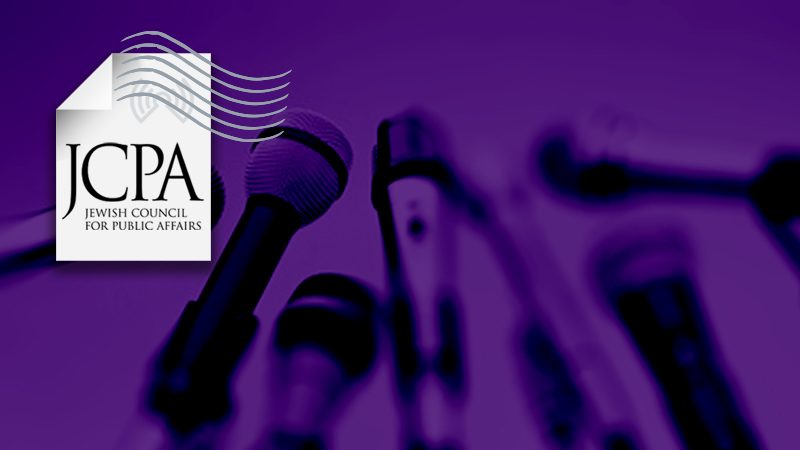David Harris

How You Help: The Return of the JCRC
The Jewish Federation of Cincinnati helps the vulnerable, of course. However, the Jewish Federation, as you know, also funds an organization doing critical advocacy work on behalf of our entire Jewish community—the Jewish Community Relations Council (JCRC). The following article, published this week in eJewish Philanthropy, describes the growing trend of Federations to increase funding for community relations programs across the United States. We are proud to have been at the forefront of that movement. Since 1997, the JCRC has been part of the Federation, supported by your dollars.
Here’s the crucial work our JCRC is doing lately: In response to Charlottesville, our Cincinnati JCRC, along with SAFE Cincinnati, the Holocaust & Humanity Center, and the American Jewish Committee Cincinnati, convened leaders from across Cincinnati for a briefing about the status of hate groups in the United States. Approximately 130 people attended the event, including leaders from the Jewish, Islamic, and Christian communities, the African American and Hispanic communities, high schools and universities, synagogues, churches, and mosques, and many other civic organizations, as well as elected officials. The panel included nationally recognized experts such as Oren Segal, Director of the Anti-Defamation League’s Center on Extremism; Joseph Levin, Jr., cofounder of the Southern Poverty Law Center; and two supervisory special agents from the FBI.
In anticipation of white supremacist Richard Spencer’s talk at the University of Cincinnati, our JCRC is part of a new coalition of religious, community, and civic organizations being formed to address local instances of hate, including the Richard Spencer event. The coalition is working with university leaders to plan a counter-response for students and community members—occurring at the same date and time—with an inclusive and positive message.
We are also proud that three of the competent, forward-thinking leaders of our JCRC board were just elected to Cincinnati City Council—P.G. Sittenfeld, Greg Landsman, and Jeff Pastor.
The JCRC’s work could not be possible without your support. Thank you. —Danielle
The Return of the JCRC
By David Bernstein and Rabbi Doug Kahn
For many years, the Jewish community relations field was perceived to be on the decline. Jewish Federations, with some notable exceptions, reduced their community relations budgets and, in a few cases, scrapped their JCRCs altogether. There were many reasons for this trend at the time, not least a general turn inwards to deal with the Jewish continuity crisis and the likelihood of peace between Israel and the Palestinians. But it’s hard to argue that in today’s tumultuous political environment, local Jewish communities shouldn’t be maximally externally leveraged and well connected to centers of leadership and power in their broader communities.
Indeed, for the first time in more than two decades, Federations that had previously cut their JCRCs are now re-investing. Some smaller Jewish communities with no history of community relations are also developing a community relations program. Community relations is once again on the rise.
We know of at least ten Jewish communities that are in re-building mode: Oklahoma City; Stamford, Connecticut; Phoenix, Arizona; Seattle, Washington; Orange County, California; York and Reading Pennsylvania; and Atlanta, Georgia. These include Jewish communities ranging in size from 700 to more than 100,000.
We at the Jewish Council for Public Affairs (JCPA) wanted to understand what led to this positive trend and what lessons might be gleaned from the diverse array of Jewish communities that made this decision.
So we asked Rabbi Doug Kahn, Executive Director emeritus of the San Francisco JCRC, to interview the lay and staff leaders of these JCRCs and Federations to put together a portrait of this phenomenon. What we learned is that while there is no single catalyst for the creation or re-establishment of these JCRCs, all are attuned to significant changes in the external environment. The most common rationales are:
- A deep concern about declining cohesion and increased polarization within the Jewish community and a belief that an effective JCRC could build bridges within as well as beyond the Jewish community;
- A sense of urgency about growing anti-Semitism, hate and racism in American society and the need to build coalitions to address these challenges;
- A need generally to have a larger Jewish communal voice on public affairs issues of concern to the community and a collective voice to respond to specific local issues;
- A recognition that no table exists around which to bring together the disparate voices of the organized Jewish community – including to address local issues;
- Growing awareness of the importance of forging closer relations with major minority groups in American society (e.g. African-American and Latino Americans), to find common ground on issues of mutual concern and to forestall increased anti-Israel sentiment;
- Increased awareness about the importance and value of JCRC government relations work in identifying public resources for Jewish social service agencies.
JCPA has reached out to each of these communities to help them in their early stages and to build a strong relationship. And we have produced a JCRC starter kit, hosted professional development webinars and in-person training, and created a series of planning resources in order to foster this nascent trend. Our hope is that Federations will take note, and invest in a resurgent community relations field. The Jewish community needs a stronger external presence. And that begins in every Federated community.
—David Bernstein is President and CEO of the Jewish Council for Public Affairs. Rabbi Doug Kahn is Executive Director emeritus of the San Francisco JCRC.

